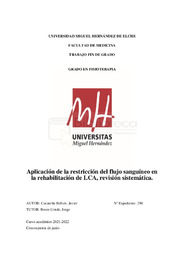Por favor, use este identificador para citar o enlazar este ítem:
https://hdl.handle.net/11000/28196Registro completo de metadatos
| Campo DC | Valor | Lengua/Idioma |
|---|---|---|
| dc.contributor.advisor | Roses Conde, Jorge | - |
| dc.contributor.author | Cucarella Bellvís, Javier | - |
| dc.contributor.other | Departamentos de la UMH::Patología y Cirugía | es_ES |
| dc.date.accessioned | 2022-11-03T08:40:53Z | - |
| dc.date.available | 2022-11-03T08:40:53Z | - |
| dc.date.created | 2022-06-20 | - |
| dc.identifier.uri | https://hdl.handle.net/11000/28196 | - |
| dc.description.abstract | Introducción: Las lesiones del ligamento cruzado anterior (LCA) pueden poner fin a la carrera de los atletas y ser gravemente incapacitantes para todos los individuos. La evidencia acerca de los beneficios e importancia de la aplicación del ejercicio terapéutico para afrontar la rehabilitación en estas lesiones es abundante y uno de sus objetivos es la ganancia de fuerza muscular. En esta línea, parece que, el ejercicio de baja intensidad combinado con BFR está demostrando su efectividad. Objetivos: Conocer el efecto del entrenamiento con restricción parcial del flujo sanguíneo en la rehabilitación de LCA, así como conocer los parámetros y tipos de ejercicios efectivos y seguros en el entrenamiento con restricción parcial del flujo sanguíneo. Material y métodos: Se buscaron artículos publicados a partir de 2017 en las bases de datos Pubmed, PEDro, ScienceDirect y Scopus, que tratarán de determinar la efectividad del entrenamiento con restricción del flujo sanguíneo (BFRT) en pacientes con lesión del LCA, algunos pre-intervención, otros post-quirúrgicos. Resultados: Se incluyeron 8 estudios. Cuatro artículos tienen un grupo control dentro de sus intervenciones, otros dos artículos comparan la técnica BFR con diferentes cargas de ejercicio, que comparan intervenciones de baja carga y alta carga, y otro estudio compara en diferentes tipos de contracción muscular, excéntrico y concéntrico. Conclusiones: Un protocolo de ejercicios de cadena cinética cerrada, como el ejercicio de prensa de pierna de baja intensidad, con una oclusión del manguito del 80% del LOP individualizado puede favorecer significativamente en la fuerza de cuádriceps e isquiotibiales, aumentar el volumen y además de reducir el dolor de rodilla en la rehabilitación temprana del LCA. | es_ES |
| dc.description.abstract | Introduction: Injuries in anterior cruciate ligament (ACL) can be career-ending for athletes and severely incapacitating for everybody. There is plenty of evidence about the benefits and importance of the application of therapeutic exercise to confront the rehabilitation of these injuries and one of its objectives is the gain of muscle strength. In this line, low intensity exercise combined with BFRT seems to be effective. Objectives: To determine the effect of training with partial blood flow restriction in ACL rehabilitation, as well as to determine the parameters and types of effective and safe exercises in training with partial blood flow restriction. Material and methods: We searched for articles published from 2017 in Pubmed, PEDro, ScienceDirect and Scopus databases, which will try to determine the effectiveness of training with blood flow restriction (BFRT) in patients with ACL injury, some pre-intervention and the other ones post-surgery. Results: Eight studies were included. Four articles have a control group within their interventions, two other articles compare the BFR technique with different exercise loads, comparing low load and high load interventions, and another study compares different types of muscle contraction, eccentric and concentric. Conclusions: A closed kinetic chain exercise protocol, such as the low intensity leg press exercise, with an individualized 80% LOP cuff occlusion can significantly benefit quadriceps and hamstring strength, increase volume and reduce knee pain in early ACL rehabilitation, too. | es_ES |
| dc.format | application/pdf | es_ES |
| dc.format.extent | 30 | es_ES |
| dc.language.iso | spa | es_ES |
| dc.publisher | Universidad Miguel Hernández | es_ES |
| dc.rights | info:eu-repo/semantics/openAccess | es_ES |
| dc.rights | Attribution-NonCommercial-NoDerivatives 4.0 Internacional | * |
| dc.rights.uri | http://creativecommons.org/licenses/by-nc-nd/4.0/ | * |
| dc.subject | BFRT | es_ES |
| dc.subject | Restricción del flujo sanguíneo | es_ES |
| dc.subject | Ligamento cruzado anterior | es_ES |
| dc.subject | ACL | es_ES |
| dc.subject.other | CDU::6 - Ciencias aplicadas | es_ES |
| dc.title | Aplicación de la restricción del flujo sanguíneo en la rehabilitación de LCA, revisión sistemática. | es_ES |
| dc.type | info:eu-repo/semantics/bachelorThesis | es_ES |

Ver/Abrir:
TFG JAVIER CUCARELLA BELLVIS.pdf
794,97 kB
Adobe PDF
Compartir:
 La licencia se describe como: Atribución-NonComercial-NoDerivada 4.0 Internacional.
La licencia se describe como: Atribución-NonComercial-NoDerivada 4.0 Internacional.
.png)